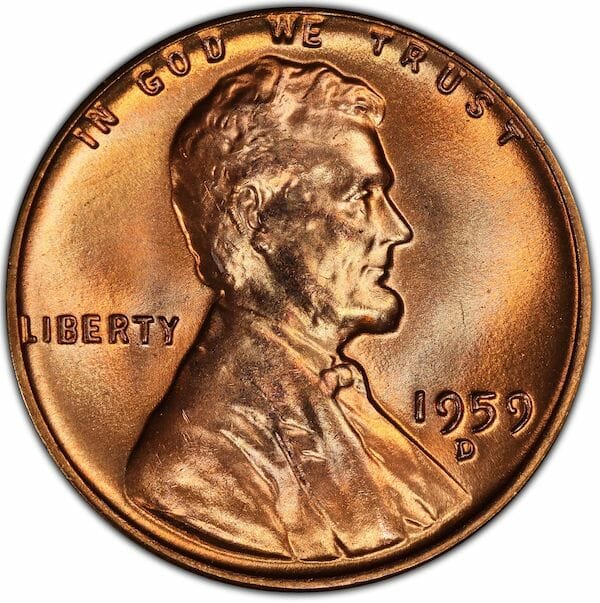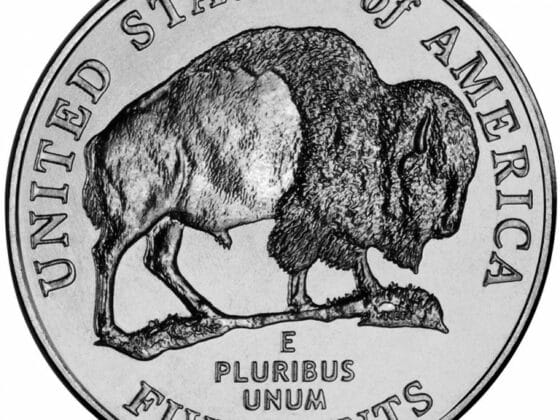In the numismatics realm, the 1959 Lincoln Penny holds a special place as the harbinger of change. This unassuming copper coin marked the departure from the iconic “wheat ears” design, prevalent from 1909 to 1958, to the distinguished Lincoln Memorial.
Honoring the 150th anniversary of President Abraham Lincoln’s birth in 1809, this transformation altered the coin’s appearance. It paved the way for intriguing errors and variations that continue to captivate collectors and enthusiasts alike. This article explores the design, composition, value, mintage, and errors associated with the 1959 Lincoln Penny.
Table of Contents
The 1959 Penny Design & Composition
Obverse Side

The obverse of the 1959 Penny continued to feature the dignified image of Abraham Lincoln, paying tribute to the revered 16th President of the United States. This timeless design, created by Victor D. Brenner, remained unchanged, providing a sense of continuity amidst the transition.
You’ll see President Lincoln wearing a coat over his shirt with a beautiful bow tie facing right. The word “LIBERTY” is embossed to the left of his profile. Inscribed above Lincoln’s head along the coin’s upper edge is the American phrase “IN GOD WE TRUST.”
The mint year is struck near Lincoln’s chest, just below the chin. If the Penny is from Denver Mint, the mintmark “D” will appear below the mint year between 9 and 5. Lincoln pennies produced by the Philadelphia in 1959 have no mintmark.
Reverse Side

The reverse, however, witnessed a significant shift. Departing from the familiar wheat ears, the Lincoln Memorial took center stage, immortalizing the architectural marvel that graces Washington, D.C. This new design by Frank Gasparro was a nod to history, a visual representation of a nation’s progress, and a testament to Lincoln’s enduring legacy. Between the central pillars is Abraham Lincoln’s statue.
Struck on the coin’s upper rim is the country name, “UNITED STATES OF AMERICA,” and surrounds the monument, running from left to right. The famous Latin phrase “E PLURIBUS UNUM” appears below the country name and just above the memorial.
Beneath the Lincoln Memorial is the denomination “ONE CENT,” appearing in a larger font than other words on the Penny. The designer’s initials “FG” also appear on the right next to the stairs of the front Memorial entrance.
Composition & Dimensions
Comprising 95% copper and a combination of 5% zinc and tin, the 1959 Penny shared its predecessors’ composition, ensuring a distinct reddish-brown hue. With a diameter of 19.00 millimeters (0.74803 inches) and a weight of 3.11 grams (0.10934 ounces), it retained the familiar dimensions, making it easily recognizable to numismatists. This one-cent coin is round, 1.52 mm (0.05984 inches) thick, and has a simple plain edge.
The 1959 Penny Value
The value of a 1959 Penny varies depending on its condition, mint mark, and potential errors. While well-circulated pieces hold sentimental value, uncirculated specimens are highly coveted by collectors. The Denver Mint produced many coins, contributing to their accessibility in the numismatic market.
A 1959 Lincoln Memorial Penny in Uncirculated (MS+) Mint condition is worth between $0.23 and $1.16. Proof Coins can fetch $3.38 or more. Some rare specimens go for extraordinary amounts at auctions. For example, a 1959 Proof Lincoln Penny graded PR60 sold for $20,700 in 2004. Another specimen in the same grade was sold for $4,313 in 2009.
1959 D Penny

The Denver Mint produced 1,279,760,000 Lincoln pennies in 1959, registering the largest mintage of this coin series. These coins are easily differentiated from those struck in Philadelphia as their reverse bears the mintmark “D.”
1959 D Penny Value
The 1959 Lincoln penny generally holds a modest value because of its widespread circulation, making it a familiar piece for collectors. Its worth can range from a mere cent to over 62 cents, contingent on its condition.
Uncirculated specimens and coins with specific errors command higher prices in the numismatic market. For instance, in 2021, a 1959 D Lincoln RD Cent graded in MS68 and authenticated by NGC sold for $6,999 in an eBay auction. Another specimen graded by PCGS in MS67+ fetched $2,640 at Heritage Auctions.
1959 Penny No Mint Mark

The Philadelphia Mint struck 609,715,000 Lincoln Memorial pennies without a mint mark in 1959. While not as abundant as their Denver counterparts, these coins are still relatively accessible.
1959 Penny No Mint Mark Value
With such a considerably high number, the average value of a 1959 Penny with no mint mark is low. Most won’t exceed their face value, but the final price varies depending on the copper price. Each piece is worth $0.0244 in the current raw material market.
Expect to sell your coin at a premium price, especially if it is in pristine condition. For example, a 1959 Lincoln Penny in MS66 condition with a less appealing red-brown appearance sold for $638 at an eBay auction in 2020. Before this, a collector spent a whopping $5,887 on a 1959 Lincoln Penny with a beautiful red toning in MS67+ condition in 2016.
How Much is a 1959 Penny Worth – (Summary)
- Circulated 1959 Penny: Typically holds sentimental value.
- Uncirculated 1959 Penny: Ranges between $0.23 to $1.16.
- 1959 Proof Lincoln Penny: Can fetch up to $3.38 or more.
- High-Grade Specimens: Sold for amounts like $20,700 (2004) and $4,313 (2009) at auctions.
- 1959-D Penny: Commonly found between one to 62 cents, but can be higher for specific conditions or errors.
- 1959 Penny No Mint Mark: Generally doesn’t exceed face value, but pristine examples have sold for $638 (2020) and even $5,887 (2016) at auctions.
- Error Coins: Their value can greatly vary, with some, like the 1959 D Mule penny, fetching an impressive $50,000 in 2019.
1959 Penny Value Chart
A comprehensive chart detailing the value spectrum of 1959 pennies aids collectors and enthusiasts in understanding the market dynamics, enabling informed decisions. Here’s the overview of the Penny’s potential values in different conditions:
| Date | Coin Condition | ||||
| MS60 | MS62 | MS64 | MS66 | MS67 | |
| 1959 RD Penny No Mint Mark (Philadelphia) | $2 | $3 | $6 | $22 | $340 |
| 1959 D RD Penny (Denver) | $0.4 | $0.6 | $1.5 | $12 | $130 |
1969 Wheat Penny Error List & Associated Indicative Values
The allure of the 1959 Lincoln Memorial Penny extends beyond its regular mintages, captivating numismatists with a fascinating array of errors. Some of the most common errors associated with the 1959 Penny include:
1959-D Wheat Penny
One of the notable anomalies tied to the 1959 Penny is the purported presence of a 1959-D Penny that showcases the wheat ear reverse, a stark deviation from the newer Lincoln Memorial design. If genuine, this discrepancy, often termed the “mule coin,” would indicate a significant minting oversight, suggesting the Denver Mint inadvertently used an outdated reverse die. Yet, within the numismatic circle, there’s a prevailing caution due to worries of counterfeiting, which somewhat tempers the enthusiasm around this find.
The 1959 D Mule Penny is a rare find and incredibly valuable, hence highly sought after by many collectors. One specimen was sold for an impressive $50,000 in 2019, having been offered by Ira & Larry Goldberg, famous numismatic auctioneers.
Doubled Dies

Doubled die errors, identified in some 1959 pennies, arise from misalignments between the die and the coin at the time of minting. These discrepancies result in replicated features on the coin, enhancing its uniqueness. Collectors prize such coins for their distinctive characteristics and the intricate craftsmanship they represent.
A 1959 Double Die Obverse Lincoln Cent graded MS65 RD by PCGS was sold for $230 in 2018 at an eBay auction. The PCGS Price Guide also estimates that the same piece is worth $500.
Re-punched Mint Marks (RPMs)

Before the advent of modern minting techniques in 1990, mint marks were manually punched into dies, leading to the possibility of errors. Some 1959-D pennies exhibit re-punched mint marks, where the mint mark was stamped over an initial incorrect placement. These RPMs showcase the human element in coin production, emphasizing the artistry and imperfections of the minting process.
A 1959 D/D RPM Lincoln Memorial cent is worth $14.99 on eBay. This price can skyrocket depending on its condition and rarity.
Off-Center Strikes

Off-center strikes, a fairly standard error across various coins, are also found in 1959 pennies. These errors occur when the coin blank isn’t properly centered during striking, resulting in a partially imprinted design. While not as rare as other errors, off-center strikes offer collectors a glimpse into the intricacies of minting.
If you have a 1959 D Lincoln Penny with this error, you can sell it for about $25 on a platform like eBay. However, the price may vary depending on the magnitude of the off-strike.
Die Breaks and Cuds
Die breaks and cuds represent fascinating errors due to the deterioration of the die used in the coin’s production. Die breaks manifest as raised lines or areas on the coin, whereas cuds appear as raised, blob-like formations. These errors, stemming from the wear and tear of the dies, add character to the coin, captivating collectors with their unique imperfections.
A 1959 Lincoln Die Break Cud Mint Error cent is rare and can fetch a few hundred dollars at auction, if not thousands.
Die Clashes

Die clashes, another intriguing error, arise when the obverse and reverse dies come into contact without a coin planchet between them. This contact results in parts of the design from one side appearing on the other, creating visually striking errors.
A die-clash error is a testament to the intricate dance between precision and chance in minting. NGC Coin estimates the starting price of a 1959 Lincoln Penny with a Die Clash error is around $15.
Conclusion
The 1959 Lincoln Penny, with its historic design shift and captivating errors, continues to enthrall numismatists and collectors worldwide. Beyond its monetary value, this unassuming copper coin embodies the artistry, craftsmanship, and occasional imperfections that define the world of coin collecting. As collectors unearth these gems, each coin narrates a unique story, inviting enthusiasts to delve into the intricate tapestry of American numismatic history.











